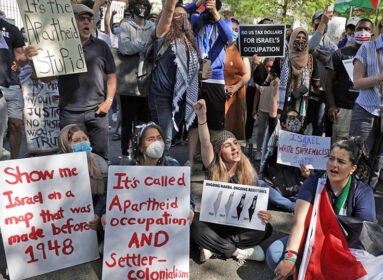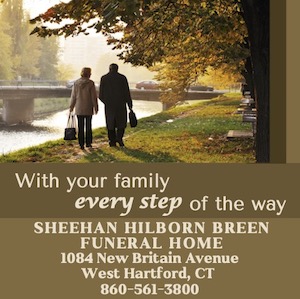“L’Chaim: To Life, “an award-winning documentary by New Milford filmmakers to screen in Sherman on July 23.
In 1794, when much of Poland was absorbed into Russia, a new decree restricted the area’s four million Jews to an area known as the Pale of Settlement. As if the onerous parameters of employment, military service, taxation, mobility, and education weren’t enough, conditions worsened in the mid-1850s, when Tsar Alexander II initiated economic reforms that further marginalized the Jewish population.

A Russian-Jewish cobbler
In response, Jewish railroad entrepreneur Samuel Poliakov and St. Petersburg University professor Nikolai Bakst petitioned the Tsar for permission to establish a Jewish charitable fund to establish vocational education for the impoverished Jews in the Pale.
In 1880, by order of the Minister of Interior Affairs, the Organization for the Distribution of Artisanal and Agricultural Skills was established. Known by the acronym of its Russian name – Obshestvo Remeslenofo zemledelcheskofo Truda, The Society for Trades and Agricultural Labour – ORT grew into an international organization whose mission is “educating for life.”
In 1969, to mark the organization’s 90th anniversary, Women’s American ORT commissioned renowned documentary filmmakers Harold and Lynne Rhodes Mayer to create a historical tribute to ORT International. The highly acclaimed result, “L’Chaim: To Life,” will be presented by the Mayers on Saturday, July 23 at the Jewish Community Center in Sherman. The Mayers had a summer home in New Milford at the time and now live there year round.
Narrated by actor Eli Wallach, the film goes far beyond ORT’s origins and work to describe more than a century of Jewish life in Russia. Through a combination of Roman Vishniac’s still photos and archival footage, the Mayers recreate the life of the Russian-Jewish community from the shtetl through World War I, the Holocaust, the Warsaw Ghetto, the Displaced Persons camps, and the establishment of the State of Israel.

Harold and Lynne Mayer
Described as “a stab at the heart and the mind” by the New York Times, the film was the most-watched public service TV program of its time, appearing on all networks and in theaters. The New York Daily News wrote, “‘L’Chaim: To Life’ should be shown every day forever.” The San Francisco Examiner hailed the documentary as “Stunning, shocking, dismaying, electrifying, exalting.”
Born in Brooklyn in 1918, Mayer knew he would be a documentary filmmaker after he watched “Native Land,” a 1942 film by Leo Hurwitz and Paul Strand that depicts racial discrimination and union-busting in 1930s America.
Three years later, as a combat rifleman with the 36th Infantry Division during World War II, Mayer was severely wounded in the Vosges Mountains on the French-German border. After recovering, he found work on the second crew of Leo Hurwitz’s 1948 documentary film, “Strange Victory,” that explores racism in the U.S. after the war.
Mayer became assistant film officer at the UN in New York for four years, then worked as associate producer and director on films and educational series for CBS, NBC, and ABC.
In 1961, he formed Harold Mayer Productions and made several films for National Educational Television, which became the Public Broadcasting Service (PBS) in 1970.
Mayer met his future wife, Lynne Rhodes, after she graduated from the University of Wisconsin and returned to New York to work with the Amalgamated Clothing Workers. While in school, Rhodes had been a writer for a student radio show exploring racial discrimination. She joined Harold Mayer Productions as writer and co-producer, and the couple made films for educational television and not-for-profit organizations.
“We’re in favor of social justice,” Mayer says. “All the work we did, in one way or another, has to do with social justice.” Their 1964 film, “The Inheritance,” a depiction of immigrants coming to the U.S. in the early 1900s, took “Best of” awards at film festivals throughout the world, and is still used in high-school and university courses.
In addition to the innovative use of still photos and archival film footage, “L’Chaim: To Life” incorporates a novel stylistic technique, devised by Lynne. “We changed ‘they’ to ‘you,'” Mayer explains. “‘You’ were not allowed to leave the ghetto. ‘You’ had to get off the street and bow if a German walked by. ‘You’ lived this way, ‘you’ died this way. We wanted to make the viewing experience more personal.”
The Mayers permanently relocated to New Milford after Harold suffered a heart attack in 1980. There they completed two final films for ORT International, in Iran and France. At 93, Mayer still receives orders for his films and is involved in the local community as chairman of the watershed committee of the Candlewood Lake Authority in Sherman.
“Every once in a while someone will call and say, ‘You changed my life,'” Mayer says. “They tell me that our films helped them understand the nature of our country.”
Filmmakers Harold and Lynne Rhodes Mayer present “L’Chaim: To Life” at the JCC in Sherman, 9 Route 39 South, Sherman, on Saturday, July 23 at 7:30 p.m., followed by Q&A and dessert. Reservations requested: (860) 355-8050 / jccinsherman@yahoo.com








 Southern New England Jewish Ledger
Southern New England Jewish Ledger










